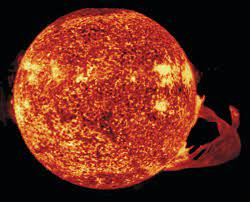A outlined chart revealing solar pattern sunspots
The Starlink devastation celebration
In February 2022, SpaceX released 49 Starlink world wide web gpses right in to a low-Earth orbit (LEO). This was actually the 36th Starlink introduce that SpaceX possessed executed, as well as one that they expected towards go off easily, much like the 35 just before.On introduce time, a coronal mass ejection — a sizable ruptured of plasma eliminated coming from the sunlight — happened Planet. It induced a geomagnetic tornado in the setting in between all around one hundred as well as five hundred kilometres in elevation, the intended variation for Starlink.
This celebration infused a great volume of electro-magnetic power right right in to Earth's higher setting. It made lovely auroral shows, however the power additionally raised the quality of the sky. A much higher sky quality normally isn't really a significant package for LEO gpses, considering that it is presently exceptionally reduced at common functional altitudes (up of 400 kilometres).
Starlink, having said that, was actually in the beginning released right in to an elevation of 210 kilometres. That is considerably deeper towards Planet, along with an greatly greater sky quality. Thirty-eight away from those 49 preliminary introduce gpses were actually ultimately dropped because of atmospheric yank coming from the thick setting, drawing all of them rear towards Planet.
Starlink gpses melting up in the setting over Puerto Rico, Feb. 7, 2022.
Shocking solar pattern
The sunlight undertakes a pattern — an 11-year one, to become particular — where its own task raises as well as reduces regularly. At the optimal of a pattern, our company find much a lot extra sunspots on the solar surface area, much a lot extra radiation released, as well as much a lot extra solar flares. Geomagnetic hurricanes just like the one that induced the Starlink devastation celebration are actually a pretty popular event, specifically when the sunlight gets to the optimal of its own 11-year pattern of building up as well as damaging task.
In the previous pattern, which finished in 2019 (the 24th tracked pattern given that 1755), certainly there certainly were actually 927 hurricanes classified as modest or even feeble alone — approximately one every 5 approximately times.
We're presently 4 years right in to solar pattern 25, however this has actually presently confirmed shocking. The optimum task of the 25th pattern was actually anticipated towards develop in 2025, however solar task has actually presently gone beyond that. This suggests we've been actually finding much a lot extra geomagnetic hurricanes, much a lot extra auroral shows (as well as at reduced latitudes compared to common) as well as, possibly, much a lot extra unsafe ailments for LEO gpses.
A outlined chart revealing solar pattern sunspots
Solar task as the amount of sunspots obvious on the solar surface area. The amount of sunspots found is actually presently notably more than exactly just what is actually gotten out of the solar optimum, pair of years in advance of timetable. (Nationwide Oceanic as well as Atmospheric Administration)
Area endure — the hidden power of attributes
If geomagnetic hurricanes are actually therefore popular, why do not they induce much a lot extra troubles? The truth is actually that they perform, however the outcomes are actually considerably much less noticeable compared to gpses melting up in the setting.
When area endure power gets in Earth's higher setting, for instance, the ionospheric structure improvements besides the sky receiving denser. High-frequency, or even "shortwave," broadcast interaction depends upon a expected ionosphere towards program long hauls.
Geomagnetic hurricanes that have an effect on ionospheric structure may induce broadcast blackouts, including a interruption in North United states on Aug. 7. Also small hurricanes may induce the deterioration of broadcast signs utilized in army as well as naval devices, aeronautics interaction or even pork broadcast.



